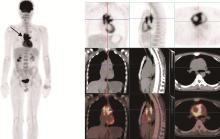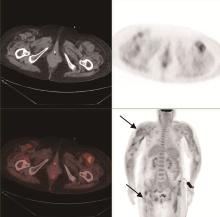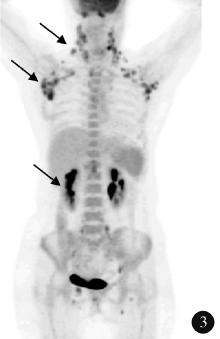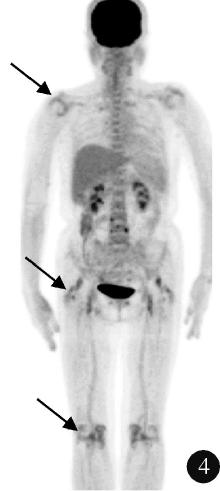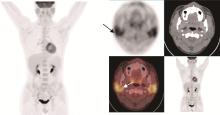Journal of Peking University (Health Sciences) ›› 2024, Vol. 56 ›› Issue (5): 853-859. doi: 10.19723/j.issn.1671-167X.2024.05.016
Previous Articles Next Articles
Application of 18F-FDG PET/CT in rheumatic diseases
Hua ZHONG1, Yuan LI2, Liling XU1, Mingxin BAI1, Yin SU1,*( )
)
- 1. Department of Rheumatology and Immunology, Peking University People's Hospital; Beijing Key Laboratory for Rheumatism Mechanism and Immune Diagnosis, Beijing 100044, China
2. Department of Nuclear Medicine, Peking University People's Hospital, Beijing 100044, China
CLC Number:
- R593.2
| 1 | Yamashita H , Kubota K , Mimori A . Clinical value of whole-body PET/CT in patients with active rheumatic diseases[J]. Arthritis Res Ther, 2014, 16 (5): 423. |
| 2 | Kubota K , Yamashita H , Mimori A . Clinical value of FDG-PET/CT for the evaluation of rheumatic diseases: rheumatoid arthritis, polymyalgia rheumatica, and relapsing polychondritis[J]. Semin Nucl Med, 2017, 47 (4): 408- 424. |
| 3 | 王冬艳, 杨彦松, 邵小南, 等. 18F-FDG PET/CT在风湿性疾病的初步应用[J]. 中国医学影像学杂志, 2015, 23 (10): 759- 763. |
| 4 | Dejaco C , Ramiro S , Duftner C , et al. EULAR recommendations for the use of imaging in large vessel vasculitis in clinical practice[J]. Ann Rheum Dis, 2018, 77 (5): 636- 643. |
| 5 | Rehak Z , Sprlakova-Pukova A , Kazda T , et al. 18F-FDG PET/CT in polymyalgia rheumatica: A pictorial review[J]. Br J Radiol, 2017, 90 (1076): 20170198. |
| 6 | Ebbo M , Grados A , Guedj E , et al. Usefulness of 2-[18F]-fluoro-2-deoxy-D-glucose-positron emission tomography/computed tomography for staging and evaluation of treatment response in IgG4-related disease: A retrospective multicenter study[J]. Arthritis Care Res, 2014, 66 (1): 86- 96. |
| 7 | Zhang J , Chen H , Ma Y , et al. Characterizing IgG4-related disease with 18F-FDG PET/CT: A prospective cohort study[J]. Eur J Nucl Med Mol Imaging, 2014, 41 (8): 1624- 1634. |
| 8 | Martinez-Pimienta G , Noriega-álvarez E , Simó-Perdigó M . Study of systemic disease IgG4. Usefulness of 2-[18F]-fluoro-2-deoxy-D-glucose-positron emission tomography/computed tomography for staging, selection of biopsy site, evaluation of treatment response and follow-up[J]. Eur J Rheumatol, 2017, 4 (3): 222- 225. |
| 9 | Lee J , Hyun SH , Kim S , et al. Utility of FDG PET/CT for differential diagnosis of patients clinically suspected of IgG4-rela-ted disease[J]. Clin Nucl Med, 2016, 41 (5): 237- 243. |
| 10 | An YS , Suh CH , Jung JY , et al. The role of 18F-fluorodeoxyglucose positron emission tomography in the assessment of disease activity of adult-onset Still's disease[J]. Korean J Intern Med, 2017, 32 (6): 1082- 1089. |
| 11 | Yamashita H , Kubota K , Takahashi Y , et al. Clinical value of 18F-fluoro-dexoxyglucose positron emission tomography/computed tomography in patients with adult-onset Still's disease: A seven-case series and review of the literature[J]. Mod Rheumatol, 2014, 24 (4): 645- 650. |
| 12 | Yoo DH . Utility and drawbacks of 18F-fluorodeoxyglucose positron emission tomography in the evaluation of adult-onset Still's disease[J]. Korean J Intern Med, 2017, 32 (6): 998- 1001. |
| 13 | Sondag M , Guillot X , Verhoeven F , et al. Utility of 18F-fluoro-dexoxyglucose positron emission tomography for the diagnosis of polymyalgia rheumatica: A controlled study[J]. Rheumatology, 2016, 55 (8): 1452- 1457. |
| 14 | Takahashi H , Yamashita H , Kubota K , et al. Differences in fluorodeoxyglucose positron emission tomography/computed tomography findings between elderly onset rheumatoid arthritis and polymyalgia rheumatica[J]. Mod Rheumatol, 2015, 25 (4): 546- 551. |
| 15 | D'Agostino MA , Haavardsholm EA , van der Laken CJ . Diagnosis and management of rheumatoid arthritis; What is the current role of established and new imaging techniques in clinical practice?[J]. Best Pract Res Clin Rheumatol, 2016, 30 (4): 586- 607. |
| 16 | Bhattarai A , Nakajima T , Sapkota S , et al. Diagnostic value of 18F-fluorodeoxyglucose uptake parameters to differentiate rheumatoid arthritis from other types of arthritis[J]. Medicine, 2017, 96 (25): e7130. |
| 17 | Chaudhari AJ , Ferrero A , Godinez F , et al. High-resolution 18F-FDG PET/CT for assessing disease activity in rheumatoid and psoriatic arthritis: Findings of a prospective pilot study[J]. Br J Radiol, 2016, 89 (1063): 20160138. |
| 18 | Suto T , Okamura K , Yonemoto Y , et al. Prediction of large joint destruction in patients with rheumatoid arthritis using 18F-FDG PET/CT and disease activity score[J]. Medicine, 2016, 95 (7): e2841. |
| 19 | Lee DH , Yoon JK , Yoon SH , et al. Physiologic facial muscle uptake on 18F-FDG PET/CT by chewing-like habitual movement in patient with Sjögren syndrome[J]. Clin Nucl Med, 2015, 40 (3): 268- 269. |
| 20 | Sharma P , Chatterjee P . 18F-FDG PET/CT in multisystem Sjögren syndrome[J]. Clin Nucl Med, 2015, 40 (5): 293- 294. |
| [1] | Qing PENG,Jia-jun LIU,Yan LIU,Hua SHANG,Guo TANG,Ya-xin HAN,Li LONG. Application of Padua prediction score and serum albumin level in evaluating venous thromboembolism in rheumatic inpatients [J]. Journal of Peking University (Health Sciences), 2023, 55(4): 625-630. |
| [2] | Xue-mei HA,Yong-zheng YAO,Li-hua SUN,Chun-yang XIN,Yan XIONG. Solid placental transmogrification of the lung: A case report and literature review [J]. Journal of Peking University (Health Sciences), 2023, 55(2): 357-361. |
| [3] | Xu-chu ZHANG,Jian-hua ZHANG,Rong-fu WANG,Yan FAN,Zhan-li FU,Ping YAN,Guang-yu ZHAO,Yan-xia BAI. Diagnostic value of 18F-FDG PET/CT and tumor markers (CEA, CA19-9, CA24-2) in recurrence and metastasis of postoperative colorectal moderately differentiated adenocarcinoma [J]. Journal of Peking University(Health Sciences), 2019, 51(6): 1071-1077. |
| [4] | KANG Lei, XU Xiao-Jie, FAN Yan, WANG Rong-Fu, MA Chao, FU Zhan-Li, ZHANG Jian-Hua, ZHANG Xu-Chu. Diagnostic value of fluorine-18 fluorodeoxyglucose positron emission tomography/computed tomography in fever of unknown origin [J]. Journal of Peking University(Health Sciences), 2015, 47(1): 175-180. |
|
||
